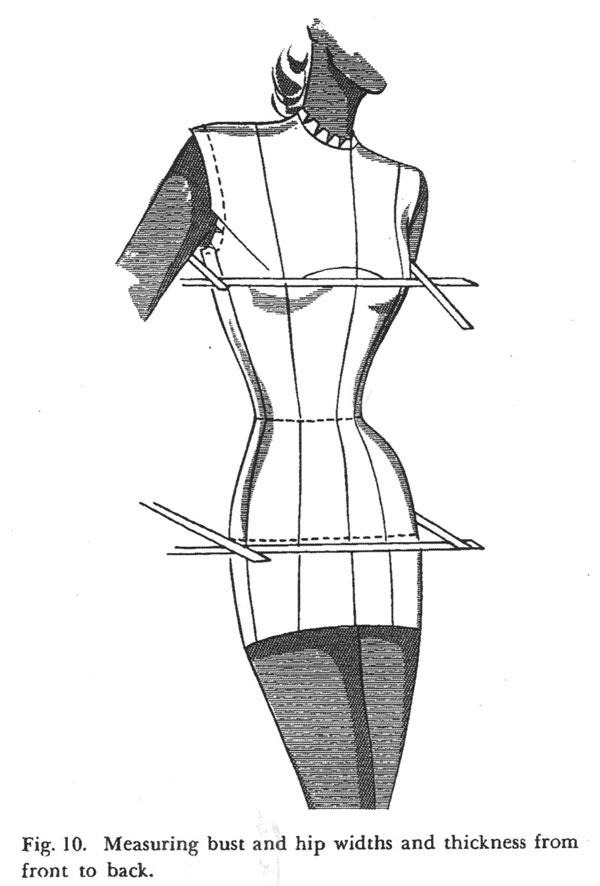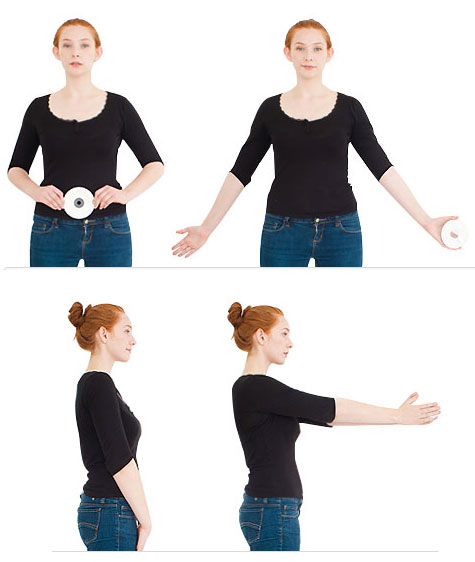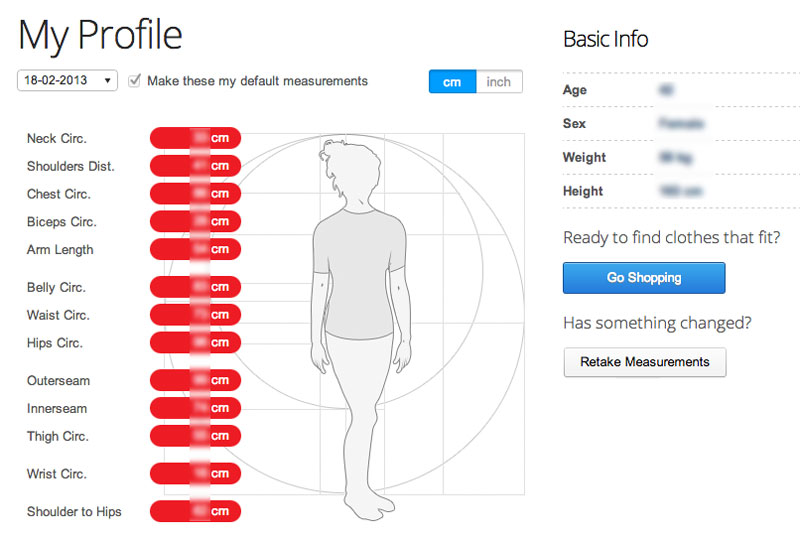
My measurements change, and frequently. It all depends on chocolate or circuit training. Or the time of the year. I am more athletic in the summer. I’m dormant in the winter. A few years ago I drafted some close-fit slopers, which I’ve occasionally used as a “body map” to correct dart and length placements on patterns, but it was time to do some re-measuring. I really want to try some pattern drafts from a few of my new-er books and every drafting style always has its own specific measurement needs.
And obviously there are some measurements that you can’t do yourself–and some which are very particular to posture. I definitely straighten up for myself. And take little smidgens off here and there. I subconsciously cheat!
So I hopped over to a friend’s house for some help in taking my current measurements. Some of the results surprised me and I wondered if she may have been holding the tape too loose. I wanted backup data. How else could I get measurements? Ooh, perhaps a body scanning? After a bit of googling about fit technology I discovered a startup company from Berlin called UPcload, who designed software that scans your body through a laptop webcam. Web 2.5 plus German technology = now that’s what I’m talkin about!
Like the few 3D scanning technologies that have trickled down to retail, this is aimed at shoppers who want to find better-fitting store clothing and it supports itself through retail partnerships. But I was curious what it could do for me in terms of pattern-drafting measurements.
ETA: And IT’S FREE. (Oopsy, forgot to add that.)
So here’s how it works. After a simple sign-up process the software connects to your webcam and a flash movie begins taking you step by step through a set-up process in front of your laptop. First it has you change into tight-fitting dark clothing, with a helpful guide on what constitutes tight–and pull up your hair if you have long hair. To get an accurate body profile you move the laptop and yourself until you fit into a frame. Then you hold a CD or DVD in front of your stomach as a point of reference.
Then another movie starts taking you through the measuring process. I forgot to take screenshots of the process as I was doing it, but these are the poses…

It’s all demonstrated by this cute 20-something couple who seem very happy about the whole thing; their apartment is much cleaner and less colorful than my house (no white walls here!).
The whole thing took about 10 minutes with some swishy disco “scan” noises and voila! body measurements.

So you might be wondering, how accurate are they? I was shocked! Most of my width measurements were spot on within .5 cm of what my friend had measured. The lengths were different but those were the ones I suspected my friend had taken too loosely, so I went with UPcload’s. Of course UPcload’s measurements are minimal and I needed several others specific to the draft I am working on, but at least I got the basics!
Anyone ever done a body scanning (outside of the airport, of course!)? I’d love to hear about it. Or have you ever had a tailor or other professional measure you?
Additional notes: If drafting custom-fitting patterns is your thing, I highly recommend European Cut by Elizabeth Allemong. There are some great drafting explanations in that book, but worth the price alone is the extensive chapter on how to measure–where to hold the tape, how tight to hold it, when to use aids, etc. Few patternmaking books go into that much detail. There’s always The Art of Measuring, reprinted by Center for Pattern Design. But then that’s vintage drafting and specific to tailoring, but I’m definitely curious about it!
Would you like tips and inspiration in the craft of lingerie sewing? Sign up for my weekly eletter The Lingerie Maker.

Very interesting! I think I may be due for some remedial measuring lessons: I’m just finishing a strapless dress with corselette that doesn’t quite fit, and I’m not sure how that happened. I feel irrationally shy about the scanner, but will definitely look for the Allemong book!
Yes, I have these irrational moments in the airport scannings. I wonder what they do with them. I made the slopers from the Allemong book a few years back–they’re the ones I use as a “body map”. It took my friend and I over an hour to do all the measurements, they are so precise!
My daughter was scanned in 3D for her brace (she has scoliosis). The scan was performed with laser and her upper torso showed on a computer in 3D. The objective was to have an accurate model of her straight torso to custom made the ideal brace for the correction of her curvature. We were fascinated by the 3D model, it would make the perfect body double for sewing, at least for a few months!
Whoa! That is awesome! Off to check it out, assuming it’s not too expensive! 🙂
It’s free!
Oh my goodness! Price was exactly what was going through my mind but free!! I daren’t tell my friend who spent hours doing my measurements – it did result in complete hilarity though so there is something to be said for the traditional method…
WHOAH. WHAT. i had your post open earlier and thought it must be mucho dinero since i couldn’t find a rate! i am GOBSMACKED.
i like that word.
Hanny, it took me and a friend an hour and a half to do all the Allemong measurements… I haven’t used the book much for patterns but I’m so glad I did those! Some measurements don’t change much because they’re just bone structure. Shoulder width, back length etc… which is nice!
That is fascinating! My problem with measuring is always knowing where the should point is. Does it measure shoulder length?
Unfortunately, no. It measures front shoulder width from point across your collarbone to point. And the results were pretty accurate on that one. I liked how the Allemong book had me do actual shoulder width. You use a marker to mark the exact point of the outside tip of your shoulder bone (it has an illustration showing you how to find it), and then you tie something around your neck (maybe a necklace? I can’t remember offhand) and mark the exact spot it hits between neck and shoulder. The shoulder width is the msmt between those two dots.
What a brilliant idea. It’s great to hear that you got accurate results
I can’t believe it’s free. Excellent info, Amy. Gotta try this…
How cool is that! Free and useful. Free. This I have to try. Thanks Amy this is very very interesting. Shall check out the Allemong book too …. Oh so many things to do and so little time, as always.
How interesting! I tried it out just now and the measurements are surprisingly quite spot on like you said! Thank you for sharing, isn’t technology wonderful?!
Ya the papers were going on about this a lot last year-apparently it is ‘the future’ for people to measure themselves for online shopping (40- 60% of online purchases get returned due to bad fit and most of the returnees are women X) here’s one article from the smh. The Upcload ppl were mentioned in FT last year and I agree with them about the whole what are you doing with the data thing.. presumably they’ll use it to improve metrics for their own commercial customers (in terms of data gathering for pattern-making which means at a bare minimum, location data will be retained along with measurements). There’s a whole bunch of tutes online for diy body scanning using two DSLRs (awesome but not so much application for it yet unless you have good CAD software to play around with) and Kinect motion sensor hacks (have had a go at this, needs further refinement-pro version mentioned here and used by these guys for reals..). I was looking into this last year for pattern making purposes but I reckon it’ll take a little longer for all the kinks to be ironed out of it (I did come across someone hacking an open source version sometime in November but can’t find the link at the moment-I’ll post it when I find it again).
Nothing to do with body scanning but for some reason when I hit next or page 2 etc at the bottom of the page, instead I download your boyshorts pattern! Not sure whether this is a glitch on my end of there’s something up with the coding on your page.
Oh no! Hmm, I just tried the links and it seems to be working on my end. I hope that isn’t happening for anyone else?
This is so cool! My husband actually does most of his artwork in 3D software, and he recently used a similar service to build a 3D model of his head (I’m forgetting the name of the service right now). The model came out spot on. I’m going to have to try this for my body. It would actually be pretty cool right now, since I’ve got a big baby bump!:)
Sounds fascinating–did his service render a 3D image or just points of measure? I can’t wait till things like body scanning to dress form are more accessible to folks like me ;).
This is phenomenal! I don’t have a ton of friends (demanding home and work life) that are willing to help me take measurements – not to mention I’m kind of shy! I’m going to try this out tonight! Thanks for the incredibly useful post!
Hmmm…seems like this is no longer available to the general public? Or was there a trick, such as signing up for the trial to add to one’s website? Excited to see this and bummed that no longer appears accessible.